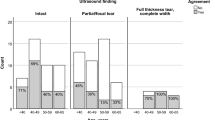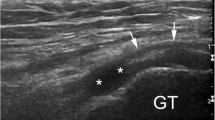Abstract
Objectives
To collate and synthesise the literature to provide estimates of the diagnostic accuracy of imaging modalities, and summarise the reported imaging findings associated with de Quervain’s syndrome.
Materials and methods
A systematic search was performed in seven databases (MEDLINE, EMBASE, CINAHL, Cochrane Library, PROSPERO, Web of Science, and ProQuest Dissertations & Theses Global). Two reviewers independently performed screening, data extraction and quality assessment using a modified Quality Assessment of Diagnostic Accuracy Studies-2. Measures of diagnostic accuracy were summarised for different modalities and imaging findings.
Results
Twenty-two studies were included, reporting ultrasound, magnetic resonance imaging, X-ray and scintigraphy findings. Reported imaging findings included sheath effusion, retinaculum thickening, subcutaneous oedema, tenosynovitis, hypervascularity, increased tendon size, bony erosion, apposition, calcific lesions and increased uptake on scintigraphy. The most commonly reported imaging findings related to the tendon sheath, with a sensitivity ranging from 0.45 to 1.00 for thickening, and 0.29 to 1.00 for effusions. The risk of bias of studies is largely unclear owing to a lack of reported detail.
Conclusions
The accuracy of imaging in the diagnosis of de Quervain’s syndrome is unable to be determined because of the quality of the studies included. Ultrasound is the most frequently studied imaging modality and may be the modality of choice in clinical practice. Further research involving both symptomatic and asymptomatic participants and clear definitions of abnormal findings are required to better evaluate the effectiveness of imaging in identifying de Quervain’s syndrome.




Similar content being viewed by others
References
Walker-Bone K, Palmer KT, Reading I, Coggon D, Cooper C. Prevalence and impact of musculoskeletal disorders of the upper limb in the general population. Arthritis Rheum. 2004;51(4):642–51.
Leslie BM, Ericson WB Jr, Morehead JR. Incidence of a septum within the first dorsal compartment of the wrist. J Hand Surg. 1990;15(1):88–91.
Lee ZH, Stranix JT, Anzai L, Sharma S. Surgical anatomy of the first extensor compartment: a systematic review and comparison of normal cadavers vs. De Quervain syndrome patients. J Plast Reconstr Aesthet Surg. 2017;70(1):127–31.
Kulthanan T, Chareonwat B. Variations in abductor pollicis longus and extensor pollicis brevis tendons in the Quervain syndrome: a surgical and anatomical study. Scand J Plast Reconstr Surg Hand Surg. 2007;41(1):36–8.
Wolf JM, Sturdivant RX, Owens BD. Incidence of de Quervain’s tenosynovitis in a young, active population. J Hand Surg Am. 2009;34(1):112–5.
Huisstede B, Coert J, Fridén J, Hoogvliet P. Consensus on a multidisciplinary treatment guideline for de Quervain disease: results from the European HANDGUIDE study. Phys Ther. 2014;94(8):1095.
Stahl S, Vida D, Meisner C, Stahl AS, Schaller H-E, Held M. Work related etiology of de Quervain’s tenosynovitis: a case-control study with prospectively collected data. BMC Musculoskelet Disord. 2015;16(1):126.
Clarke M, Lyall H, Grant J, Matthewson M. The histopathology of de Quervain’s disease. J Hand Surg. 1998;23(6):732–4.
Read H, Hooper G, Davie R. Histological appearances in post-partum de Quervain’s disease. J Hand Surg Br. 2000;25(1):70–2.
Kuo YL, Hsu CC, Kuo LC, Wu PT, Shao CJ, Wu KC, et al. Inflammation is present in de Quervain disease—correlation study between biochemical and histopathological evaluation. Ann Plast Surg. 2015;74:S146–51.
Batteson R, Hammond A, Burke F, Sinha S. The de Quervain’s screening tool: validity and reliability of a measure to support clinical diagnosis and management. Musculoskeletal Care. 2008;6(3):168–80.
Henderson RE, Walker BF, Young KJ. The accuracy of diagnostic ultrasound imaging for musculoskeletal soft tissue pathology of the extremities: a comprehensive review of the literature. Chiropr Man Therap. 2015;23(1):31.
Dawson C, Mudgal CS. Staged description of the Finkelstein test. J Hand Surg. 2010;35(9):1513–5.
Kutsumi K, Amadio PC, Zhao C, Zobitz ME, Tanaka T, An KN. Finkelstein’s test: a biomechanical analysis. J Hand Surg Am. 2005;30(1):130–5.
Goubau JF, Goubau L, Van Tongel A, Van Hoonacker P, Kerckhove D, Berghs B. The wrist hyperflexion and abduction of the thumb (WHAT) test: a more specific and sensitive test to diagnose de Quervain tenosynovitis than the Eichhoff’s test. J Hand Surg Eur Vol. 2014;39(3):286–92.
Brunelli G. Finkelstein’s versus Brunelli’s test in De Quervain tenosynovitis. Chir Main. 2003;22(1):43–5.
McInnes MD, Moher D, Thombs BD, McGrath TA, Bossuyt PM, Clifford T, et al. Preferred reporting items for a systematic review and meta-analysis of diagnostic test accuracy studies: the PRISMA-DTA statement. JAMA. 2018;319(4):388–96.
De Vet H, Eisinga A, Riphagen I, Aertgeerts B, Pewsner D. Chapter 7: searching for studies. Cochrane handbook for systematic reviews of diagnostic test accuracy: The Cochrane Collaboration; 2008.
Bhargava SK, Thukral TA. De Quervain’s disease—sonographic evaluation. Ultrasound Int. 1997;3(4):222–6.
Choi SJ, Ahn JH, Lee YJ, Ryu DS, Lee JH, Jung SM, et al. de Quervain disease: US identification of anatomic variations in the first extensor compartment with an emphasis on subcompartmentalization. Radiology. 2011;260(2):480–6.
Danda RS, Kamath J, Jayasheelan N, Kumar P. Role of guided ultrasound in the treatment of De Quervain tenosynovitis by local steroid infiltration. J Hand Microsurg. 2016;8(1):34–7.
De Keating-Hart E, Touchais S, Kerjean Y, Ardouin L, Le Goff B. Presence of an intracompartmental septum detected by ultrasound is associated with the failure of ultrasound-guided steroid injection in de Quervain’s syndrome. J Hand Surg Eur Vol. 2016;41(2):212–9.
Giovagnorio F, Andreoli C, De Cicco ML. Ultrasonographic evaluation of de Quervain disease. J Ultrasound Med. 1997;16(10):685–9.
Hadidy A, Hadidi S, Haroun A, Al-Hadidi M, Mahafza W, Badran D, et al. De Quervain’s tenosynovitis imaging: ultrasonography versus magnetic resonance imaging. J Bahrain Med Soc. 2009;21(4):328–33.
Hajder E, de Jonge MC, van der Horst CM, Obdeijn MC. The role of ultrasound-guided triamcinolone injection in the treatment of de Quervain’s disease: treatment and a diagnostic tool? Chir Main. 2013;32(6):403–7.
Knobloch K, Gohritz A, Spies M, Vogt PM. Neovascularisation in de Quervain’s disease of the wrist: novel combined therapy using sclerosing therapy with polidocanol and eccentric training of the forearms and wrists—a pilot report. Knee Surg Sports Traumatol Arthrosc. 2008;16(8):803–5.
Kwon BC, Choi SJ, Koh SH, Shin DJ, Baek GH. Sonographic identification of the intracompartmental septum in de Quervain’s disease. Clin Orthop Relat Res. 2010;468(8):2129–34.
Lee KH, Kang CN, Lee BG, Jung WS, Kim DY, Lee CH. Ultrasonographic evaluation of the first extensor compartment of the wrist in de Quervain’s disease. J Orthop Sci. 2014;19(1):49–54.
Marini M, Boni S, Pingi A, De Dominicis C, Cartolari R. De Quervain’s disease: diagnostic imaging. Chir Organi Mov. 1994;79(2):219–23.
Nagaoka M, Matsuzaki H, Suzuki T. Ultrasonographic examination of de Quervain’s disease. J Orthop Sci. 2000;5(2):96–9.
Volpe A, Pavoni M, Marchetta A, Caramaschi P, Biasi D, Zorzi C, et al. Ultrasound differentiation of two types of de Quervain’s disease: the role of retinaculum. Ann Rheum Dis. 2010;69(5):938–9.
Anderson SE, Steinbach LS, De Monaco D, Bonel HM, Hurtienne Y, Voegelin E. Baby wrist: MRI of an overuse syndrome in mothers. AJR Am J Roentgenol. 2004;182(3):719–24.
Glajchen N, Schweitzer M. MRI features in de Quervain’s tenosynovitis of the wrist. Skeletal Radiol. 1996;25(1):63–5.
Chien AJ, Jacobson JA, Martel W, Kabeto MU, Marcantonio DR. Focal radial styloid abnormality as a manifestation of de Quervain tenosynovitis. AJR Am J Roentgenol. 2001;177(6):1383–6.
Hanlon CR. DeQuervain’s disease. Am J Surg. 1949;77(4):491–8.
Nyska M, Floman Y, Fast A. Osseous involvement in de Quervain’s disease. Clin Orthop Relat Res. 1984;(186):159–61.
Suresh SS, Zaki H, Ali A. Does radial styloid abnormality in de Quervain’s disease affect the outcome of management? Hand. 2010;5(4):374–7.
Weston WJ. De Quervain’s disease—stenosing fibrous tendovaginitis at the radial styloid process. Br J Radiol. 1967;40(474):446–8.
Leslie WD. The scintigraphic appearance of de Quervain tenosynovitis. Clin Nucl Med. 2006;31(10):602–4.
Bossuyt P, Davenport C, Deeks J, Hyde C, Leeflang M, Scholten R. Cochrane handbook for systematic reviews of diagnostic test accuracy. The Cochrane Collaboration; 2008.
Kim H-R, Lee S-H. Ultrasonographic assessment of clinically diagnosed trigger fingers. Rheumatol Int. 2010;30(11):1455–8.
Sato J, Ishii Y, Noguchi H. Ultrasonographic evaluation of the prevalence of an intracompartmental septum in patients with de Quervain’s disease. Orthopedics. 2016;39(2):112–6.
Fryback DG, Thornbury JR. The efficacy of diagnostic imaging. Med Decis Making. 1991;11(2):88–94.
Kumar Y, Alian A, Ahlawat S, Wukich DK, Chhabra A. Peroneal tendon pathology: pre- and post-operative high resolution US and MR imaging. Eur J Radiol. 2017;92:132–44.
Acknowledgements
This research has been supported by an Australian Government Research Training Program Scholarship, awarded to Brodwen McBain. Ebonie Rio is supported by the National Health and Medical Research Council Early Career Fellowship Scheme.
One author, Brodwen McBain, has received funding from the Australian Government in the form of an Australian Government Research Training Program Scholarship.
Author information
Authors and Affiliations
Corresponding author
Ethics declarations
Conflicts of interest
Author, Rafal Grabinski, is a practicing radiologist, and as such receives remuneration for the delivery of radiology consultancy services. Each author certified that he or she has no other commercial association that might pose a conflict of interest in connection with the submitted article.
Ethical review committee statement
As this article is a systematic review of previously published articles, ethical approval was not required.
Additional information
Publisher’s note
Springer Nature remains neutral with regard to jurisdictional claims in published maps and institutional affiliations.
This work was performed at La Trobe Sport and Exercise Medicine Research Centre; College of Science, Health and Engineering; La Trobe University; Australia
Rights and permissions
About this article
Cite this article
McBain, B., Rio, E., Cook, J. et al. Diagnostic accuracy of imaging modalities in the detection of clinically diagnosed de Quervain’s syndrome: a systematic review. Skeletal Radiol 48, 1715–1721 (2019). https://doi.org/10.1007/s00256-019-03195-z
Received:
Revised:
Accepted:
Published:
Issue Date:
DOI: https://doi.org/10.1007/s00256-019-03195-z




